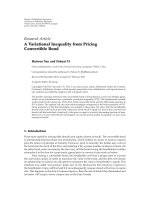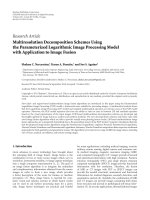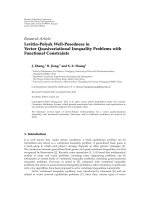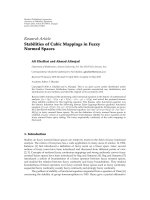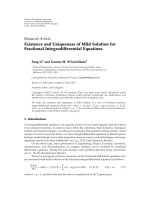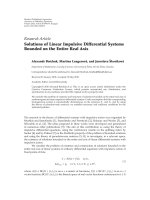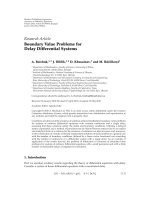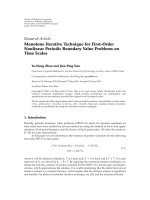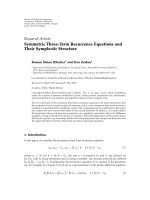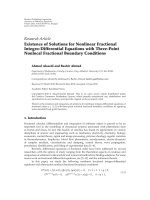Báo cáo sinh học: " Research Article Image Variational Denoising Using Gradient Fidelity on Curvelet Shrinkage" docx
Bạn đang xem bản rút gọn của tài liệu. Xem và tải ngay bản đầy đủ của tài liệu tại đây (6.88 MB, 16 trang )
Hindawi Publishing Corporation
EURASIP Journal on Advances in Signal Processing
Volume 2010, Article ID 398410, 16 pages
doi:10.1155/2010/398410
Research Article
Image Variational Denoising Using Gradient Fidelity on
Curvelet Shrinkage
Liang Xiao,
1, 2
Li-Li Huang,
1, 3
and Badrinath Roysam
2
1
School of Computer Science and Technology, Nanjing University of Science and Technology, Nanjing 210094, China
2
Department of Electrical, Computer, and Systems Engineering, Rensselaer Polytechnic Institute, Troy, NY 12180-3590, USA
3
Department of Information and Computing Science, Guangxi University of Technology, Liuzhou 545000, China
Correspondence should be addressed to Liang Xiao,
Received 27 December 2009; Revised 20 March 2010; Accepted 7 June 2010
Academic Editor: Ling Shao
Copyright © 2010 Liang Xiao et al. This is an open access article distributed under the Creative Commons Attribution License,
which permits unrestricted use, distribution, and reproduction in any medium, provided the original work is properly cited.
A new variational image model is presented for image restoration using a combination of the curvelet shrinkage method and
the total variation (TV) functional. In order to suppress the staircasing effect and curvelet-like artifacts, we use the multiscale
curvelet shrinkage to compute an initial estimated image, and then we propose a new gradient fidelity term, which is designed to
force the gradients of desired image to be close to the curvelet approximation gradients. Then, we introduce the Euler-Lagrange
equation and make an investigation on the mathematical properties. To improve the ability of preserving the details of edges and
texture, the spatial-varying parameters are adaptively estimated in the iterative process of the gradient descent flow algorithm.
Numerical experiments demonstrate that our proposed method has good performance in alleviating both the staircasing effect
and curvelet-like artifacts, while preserving fine details.
1. Introduction
Image denoising is a very important preprocessing in many
computer vision tasks. The tools for attracting this problem
come from computational harmonic analysis (CHA), varia-
tional approaches, and partial differential equations (PDEs)
[1]. The major concern in these image denoising models is to
preserve important image features, such as edges and texture,
while removing noise.
In the direction of multi-scale geometrical analysis
(MGA), the shrinkage algorithms based on the CHA tools,
such as contourlets [2]andcurvelets[3–5], are very impor-
tant in image denoising because they are simple and have
efficient computational complexity and promising properties
for singularity analysis. Therefore, the pseudo-Gibbs artifacts
caused by the shrinkage methods based on Fourier transform
and wavelets attempt to be overcame by the methods based
on MGA at least partially. However, there are still some
curve-like artifacts in MGA-based shrinkage methods [6].
Algorithms designed by variatinal and PDE models
are free from the above lacks of MGA but cost heavy
computational burden that is not suitable for time critical
application. In addition, the PDE-based algorithms tend to
produce a staircasing effect [7], although they can achieve a
good trade-off between noise removal and edge preservation.
For instance, the total variation (TV) minimizing [8] method
has some undesirable drawbacks such as the staircasing effect
and loss of texture, although it can reduce pseudo-Gibbs
oscillations effectively. Similar problem can be found in
many other nonlinear diffusion models such as the Perona-
Malik model [9] and the mean curvature motion model
[10]. In this paper, we will focus on the hybrid variational
denoising method. Specificity, we will emphasis on the
improvement on the TV model, and we will propose a
novel gradient fidelity term based on the curvelet shrinkage
algorithm.
1.1. Related Works and Analysis. To begin with, we will
review some related works of the variational methods. To
cope with the ill-posed nature of denoising, the variational
methods often use regularization technique. Let u
0
denote
the observed raw image data and u is the original good image;
2 EURASIP Journal on Advances in Signal Processing
(a) (b) (c)
Figure 1: (a) The noisy “Lena” image with standard deviation 35; (b) the denoised “Lena” image by the TV algorithm; (c) the denoised
“Lena” image by the curvelet hard shrinkage algorithm.
then the regularization functional-based denoising is given
by
u = argmin
u
{λE
data
(
u, u
0
)
+ E
smooth
(
u
)
},
(1)
where the first term E
data
(u, u
0
) is the image fidelity term,
which penalizes the inconsistency between the under-
estimated recovery image and the acquired noisy image,
while the second term E
smooth
(u) is the regularization term
which imposes some priori constraints on the original image
and to a great degree determines the quality of the recovery
image, and λ is the regularization parameter which balances
trade-off between the image fidelity term E
data
(u, u
0
) and the
regularization term E
smooth
(u).
A classical model is the minimizing total variational (TV)
functional [8]. The TV model seeks the minimal energy of an
energy functional comprised of the TV norm of image u and
the fidelity of this image to the noisy image u
0
:
u = argmin
u∈BV
(
Ω
)
E
(
u
)
=
Ω
|∇
u| +
1
2
λ
(
u
− u
0
)
2
dx dy.
(2)
Here, Ω denotes the image domain and BV(Ω) is the space
of functions of L
1
(Ω) such that the TV norm is TV(u) =
Ω
|∇u| dxdy<∞. The gradient descent evolution equation
is
∂u
∂t
= div
∇
u
|∇u|
+ λ
(
u
0
− u
)
.
(3)
In this formulation, λ can be considered as a Lagrange
multiplier, computed by
λ
=
1
|Ω|σ
2
Ω
div
⎛
⎝
∇
u
|∇u|
2
+ ε
2
⎞
⎠
(
u
− u
0
)
dx.
(4)
Although the TV model can reduce oscillations and regular-
ize the geometry of level sets without penalizing discontinu-
ities, it possesses some properties which may be undesirable
under some circumstances [11], such as staircasing and loss
of texture (see Figures 1(a)–1(c)).
Currently, there are three approaches which can partially
overcome these drawbacks. One approach to preventing
staircasing is to introduce higher-order derivatives into the
energy. In [12], an image u is decomposed into two parts:
u
= u
1
+ u
2
.Theu
1
component is measured using the
total variation norm, while the second component u
2
is
measured using a higher-order norm. More precisely, one
solves the following variational problem that now involves
two unknowns:
min
u
1
,u
2
E
(
u
1
, u
2
)
=
Ω
|∇
u
1
| + αH
(
∇u
2
)
+ λ
(
u
1
+ u
2
− u
0
)
2
dx dy.
(5)
Here H(
∇u
2
) could be some higher-order norm, for exam-
ple, H(
∇u
2
) =|∇
2
u
2
|. More complex higher-order norms
were brought to variational method in order to alleviate the
staircasing effect [13].
The second approach overcoming the staircasing effect is
to adopt the new data fidelity term. Gilboa et al. proposed
an adaptive fidelity term to better preserve fine-scale features
[14]. Zhu and Xia in [7] introduced the gradient fidelity term
defined by
E
(
u, u
0
)
=
Ω
α
(
u − u
0
)
2
dx dy
+
Ω
β∇u −∇
(
G
σ
⊗ u
0
)
2
dx dy,
(6)
where G
σ
is the Gaussian kernel with scale σ, and the symbol
“
⊗” denotes the convolution operator. Their studies show
that this gradient fidelity term can alleviate the staircasing
effect. However, classical Gaussian filtering technique is the
uniform smoothing in all direction of images and fine details
are easily destroyed with these filters. Hence, the gradient
of smoothed image is unreliable near the edges, and the
gradient fidelity cannot preserve the gradient and thereby
image edges.
The third approach is the combination of the variational
model and the MGA tools. In [14], the TV model has been
combined with wavelet to reduce the pseudo-Gibbs artifacts
resulted from wavelet shrinkage [15]. Nonlinear diffusion
EURASIP Journal on Advances in Signal Processing 3
Minimizing TV with
gradient fidelity on
curvelet shrinkage
Shrinkage
P
σ
u
0
Curvelet shrinkage
algorithm
T(u
0
, σ)
Stop?
Parameters
update
Threshold parameter λ
u
0
Noisy image
u
Figure 2: Illustrate the proposed self-optimizing image denoising approach.
has been combined with wavelet shrinkage to improve the
rotation invariance [16]. The author in [17] presented a
hybrid denoising methods in which the complex ridgelet
shrinkage was combined with total variation minimization
[6]. From their reports, the combination of MGA and PDE
methods can improve the visual quality of the restored image
and provides a good way to take full advantages of both
methods.
1.2. Main Contribution and Paper’s Organization. In this
paper, we add a new gradient fidelity term to the TV
model to some second-order nonlinear diffusion PDEs for
avoiding the staircasing effect and curvelet-like artifacts. This
new gradient fidelity term provides a good mechanism to
combine curvelet shrinkage algorithm and the TV regular-
ization.
This paper is organized as follows. In Section 2,we
introduce the curvelet transform. In Section 3,wepropose
a new hybrid model for image smoothing. In this model,
we have two main contributions. We propose a new hybrid
fidelity term, in which the gradient of multi-scale curvelet
shrinkage image is used as a feature fidelity term in order
to suppress the staircasing effect and curvelet-like artifacts.
Secondly, we propose an adaptive gradient descent flow
algorithm, in which the spatial-varying parameters are
adaptively estimated to improve the ability of preserving the
details of edges and texture of the desired image. In Section 4,
we give numerical experiments and analysis.
The pipeline of our proposed method is illustrated in
Figure 2. There are three core modules in our method. In
the first module, we apply the curvelet shrinkage algorithm
to obtain a good initial restored image P
σ
u
0
. The second
module is the minimizing TV with the new gradient fidelity,
andthismoduleisaglobaloptimizingprocesswhichis
guided by our proposed general objective functional. The
third one is the parameters adjustment module, which
provides an adaptive process to compute the value for the
system’s parameters. The rationale behind the proposed
method is that high visual quality image restoration scheme
is expected to be a blind process to filter out noise, preserve
the edge, and alleviate other artifacts.
2. Curvelet Transform
In the next, we review the basic principles of curvelets
which were originally proposed by Cand
`
es et al. in [5]. Let
W(r)(r
∈ (1/2, 2)) and V(t)(t ∈ (−1, 1)) be a pair of
smooth, non-negative real-valued functions; here W(r)is
called “radial window” and V(t) is called “angular window”.
Both of them need to satisfy the admissibly conditions:
+∞
j=−∞
W
2
2
j
r
=
1, r ∈
3
4
,
3
2
,
+∞
l=−∞
V
2
(
t
− l
)
= 1, t ∈
−
1
2
,1
.
(7)
Now, for each j
≥ j
0
, let the window U
j
in Fourier domain
be given by
U
j
(
r,θ
)
= 2
−3j/4
W
2
− j
r
V
2
j/2
θ
(
2π
)
,(8)
where
j/2 is the integer part of j/2and(r, θ) denotes the
polar coordinate; thus the support of U
j
is a polar “wedge”
which is determined by “radial window” and “angular
window”. Let U
j
be the Fourier transform of ϕ
j
(x), that
is,
ϕ
j
(x) = U
j
(ω). We may think of ϕ
j
(x) as a “mother”
curvelet in the sense that all curvelets at scale 2
− j
are
obtained by rotation and translations of ϕ
j
(x). Let R
θ
be
the rotation matrix by θ radians and R
−1
θ
its inverse, then
curvelets are indexed by three parameters: a scale 2
− j
(j ≥
j
0
), an equispaced sequence of orientation θ
j,l
= 2π ·
2
− j/2
· l (l = 1, 2 ,0 ≤ θ
l
≤ 2π), and the position
x
(j,l)
k
= R
−1
θ
j,l
(k
1
2
− j
, k
2
2
− j
)(k = (k
1
, k
2
) ∈ Z
2
). With these
parameters, the curvelets are defined by
ϕ
j,l,k
(
x
)
= ϕ
j
R
θ
j,l
x − x
(j,l)
k
.
(9)
Acurveletcoefficient is then simply the inner product
betweenanelementu
∈ L
2
(R
2
)andacurveletϕ
j,l,k
, that is,
c
j,l,k
=
u
(
x
)
, ϕ
j,l,k
=
R
2
u
(
x
)
ϕ
j,l,k
(x)dx.
(10)
4 EURASIP Journal on Advances in Signal Processing
500
400
300
200
100
100 200 300 400 500
(a)
500
400
300
200
100
100 200 300 400 500
(b)
Figure 3: The elements of wavelets (a) and curvelets on various scales, directions and translations in the spatial domain (b).
Let μ = (j,l, k) be the collection of the triple index.
The family of curvelet functions forms a tight frame of
L
2
(R
2
). That means that each function u ∈ L
2
(R
2
)hasa
representation:
u
(
x
)
=
μ
u
(
x
)
, ϕ
μ
ϕ
μ
,
(11)
where
u, ϕ
μ
denotes the L
2
-scalar product of u and ϕ
μ
.
The coefficients c
μ
(u) =u(x), ϕ
μ
are called coefficients of
function u. In this paper, we apply the second-generation
curvelet transform, and the digital implementations can be
outlined roughly as three steps [5]: apply 2D FFT, product
with frequency windows, and apply 2D inverse FFT for each
window. The forward and inverse curvelet transforms have
the same computational cost of O(N
2
log N)foranN × N
data [11]. More details on curvelets and recent applications
can be found in recent reviewer papers [3–6, 18, 19]. Figure 3
shows the elements of curvelets in comparison with wavelets.
Note that the tensor-product 2D wavelets are not strictly
isotropic but have three directions, while curvelets have
almost arbitrary directional selectivity.
3. Combination TV Minimization with
Gradient Fidelity on Cur velet Shrinkage
3.1. The Proposed Model. We start from the following
assumed additive noise degradation model:
u
0
= u + v,
(12)
where u
0
denotes the observed raw image data, u is the
original good image, and v is additive measurement noise.
The goal of image denoising is to recover u from the observed
image data u
0
. The shrinkage algorithm on some multi-scale
frame
{ϕ
μ
: μ ∈ Λ} can be written as follows:
C
μ
u
0
= C
μ
u + C
μ
v,
(13)
where C
μ
is the corresponding MGA operator, that is,
C
μ
(u) =u, ϕ
μ
,forallμ ∈ Λ,and“Λ” is a set of
indices. The rational is that the noise C
μ
v is nearly Gaussian.
The principles of the shrinkage estimators which estimate
the frame coefficients
{C
μ
u} from the observed coefficients
{C
μ
u
0
} have been discussed in different frameworks such as
Bayesian and variational regularization [20, 21].
Although traditional wavelets perform well only for
representing point singularities, they become computation-
ally inefficient for geometric features with line and surface
singularities. To overcome this problem, we choose the
curvelet as the tool of shrinkage algorithm. In general, the
shrinkage operators are considered to be in the form of a
symmetric function T : R
→ R; thus the coefficients are
estimated by
C
μ
u = T
C
μ
u
0
, ∀μ ∈ Λ. (14)
Let
{ϕ
μ
: μ ∈ Λ} denote the dual frame, and then a denoised
image P
λ
u
0
is generated by the reconstruction algorithm:
P
λ
u
0
=
μ∈Λ
T
λ
c
μ
(
u
0
)
ϕ
μ
.
(15)
Following the wavelet shrinkage idea which was proposed
by Donoho and Johnstone [22], the curvelet shrinkage
operators T
λ
(·) can be taken as a soft thresholding function
defined by a fixed threshold λ, that is,
T
λ
(
x
)
=
⎧
⎪
⎪
⎪
⎪
⎨
⎪
⎪
⎪
⎪
⎩
x − λ, x ≥ λ,
0,
|x| <λ,
x + λ, x
≤ λ.
(16)
or a hard shrinkage function
T
λ
(
x
)
=
⎧
⎨
⎩
x, |x|≥λ,
0,
|x| <λ.
(17)
EURASIP Journal on Advances in Signal Processing 5
(a) Toys image (b) Noisy for σ = 20 (c) λ = 3σ
2
(d) λ = 4σ
2
(e) λ = 5σ
2
(f) λ = 6σ
2
Figure 4: (a) Original “Toys” image. (b) Noisy “Toys” image for Gaussian noise with standard deviation σ = 20. (c)–(f) Denoising of “Toys”
image shown in (b) where the curvelet transform is hard-thresholding according to (17)fordifferent choices of λ.
The major problem with wavelet shrinkage methods, as
discussed, is that shrinking large coefficients entails an
erosion of the spiky image features, while shrinking small
coefficients towards zero yields Gibbs-like oscillation in the
vicinity of edges and loss of texture. As a new MGA tool,
Curvelet shrinkage can suppress this pseudo-Gibbs and
preserve the image edge; however, some shapes of curve-like
artifacts are generated (see Figure 4).
In order to suppress the staircasing effect and curvelet-
like artifacts, we propose a new objective functional:
E
(
u
)
= TV
(
u
)
+ E
data
(
u, u
0
)
=
Ω
|∇u| dxdy + α
x, y
Ω
(
u
− u
0
)
2
dx dy
+ β
x, y
Ω
|∇u −∇
(
P
λ
u
0
)
|
2
dx dy.
(18)
In the cost functional (18), the term
Ω
|∇u −
∇
(P
λ
u
0
)|
2
dxdy is called curvelet shrinkage-based gradient
data fidelity term and is designed to force the gradient of u to
be close to the gradient estimation
∇(P
λ
u
0
) and to alleviate
the staircase effect. And the parameters α(x, y) > 0and
β(x, y) > 0 control the weights of each term. For the sake
of simplicity for description, we always let α :
= α(x, y)and
β :
= β(x, y) in the following sections.
3.2. Basic Properties of Our Model. Let us denote
E
(
u
)
= α
Ω
(
u
− u
0
)
2
dx dy + β
Ω
|∇u −∇
(
P
λ
u
0
)
|
2
dx dy.
(19)
Then, the cost function is a new hybrid data fidelity term,
and its corresponding Euler equation is
α
(
u
0
− u
)
+ β
(
Δu − Δ
(
P
λ
u
0
))
= 0.
(20)
Proposition 1. The Euler equation (20) equals to produce a
new image whose Fourier transform is described as follows: if
α>0, β>0, then
F
(
u
)
=
αF
(
u
0
)
+ β
w
2
+ v
2
F
(
P
λ
u
0
)
α + β
(
w
2
+ v
2
)
.
(21)
Proof. Apply Fourier transform to the Euler equation (20)
andwewillget
α
(
F
(
u
0
)
− F
(
u
))
+ β
(
F
(
Δu
)
− F
(
Δ
(
P
λ
u
0
)))
= 0.
(22)
According to the differential properties of the Fourier
transform
F
(
Δu
)
(w,v)
= F
∂
2
∂x
u +
∂
2
∂y
u
(
w, v
)
=−
w
2
+ v
2
F
(
u
)
(w,v)
,
(23)
we have
α
(
F
(
u
0
)
− F
(
u
))
+ β
w
2
+ v
2
(
F
(
P
λ
u
0
)
− F
(
u
))
=
0.
(24)
If α>0, β>0, then we get
F
(
u
)
=
αF
(
u
0
)
+ β
w
2
+ v
2
F
(
P
λ
u
0
)
α + β
(
w
2
+ v
2
)
,
(25)
where w and v are parameters in the frequency domain.
6 EURASIP Journal on Advances in Signal Processing
Proposition 1 tells us that the Euler equation (20)equals
to compute a new image whose Fourier frequency spectrum
is the interpolation of F(u
0
)andF(P
λ
u
0
). The weight
coefficients of F(u
0
)andF(P
λ
u
0
)areα/(α + β(w
2
+ v
2
)) and
β(w
2
+ v
2
)/(α + β(w
2
+ v
2
)), respectively.
Proposition 2. The energ y functional E
data
(u, u
0
) is convex.
Proof. For all 0
≤ λ ≤ 1, for all u
1
, u
2
, on one hand we have
the following conclusion:
(
λu
1
+(1− λ)u
2
− u
0
)
2
≤ λ
(
u
1
− u
0
)
2
+
(
1 − λ
)(
u
2
− u
0
)
2
.
(26)
On the other hand, we have the following conclusion:
λ∇u
1
+(1− λ)∇u
2
−∇(P
λ
u
0
)
2
=λ
(
∇u
1
−∇
(
P
λ
u
0
))
+
(
1
− λ
)(
∇u
2
−∇
(
P
λ
u
0
))
2
= λ
2
∇u
1
−∇
(
P
λ
u
0
)
2
+
(
1 − λ
)
2
∇u
2
−∇(P
λ
u
0
)
2
+2λ
(
1 − λ
)
∇u
1
−∇
(
P
λ
u
0
)
,
∇u
2
−∇
(
P
λ
u
0
)
≤
λ
2
∇u
1
−∇(P
λ
u
0
)
2
+
(
1 − λ
)
2
∇u
2
−∇(P
λ
u
0
)
2
+2λ
(
1 − λ
)
∇u
1
−∇
(
P
λ
u
0
)
·∇u
2
−∇
(
P
λ
u
0
)
=
[
λ
∇u
1
−∇(P
λ
u
0
) +(1− λ)∇u
2
−∇(P
λ
u
0
)
]
2
.
(27)
Then, we have
λ∇u
1
+
(
1 − λ
)
∇u
2
−∇
(
P
λ
u
0
)
≤
λ∇u
1
−∇
(
P
λ
u
0
)
+
(
1 − λ
)
∇u
2
−∇
(
P
λ
u
0
)
.
(28)
According to (26)and(28), we get the E
data
(λu
1
+(1−
λ)u
2
, u
0
) ≤ λE
data
(u
1
, u
0
)+(1− λ)E
data
(u
2
, u
0
).
From Proposition 2, the convexity of the energy func-
tional can guarantee the global optimizing and the existence
of the unique solution, while Proposition 1 shows us that
the solution has some special form in Fourier domain.
Combining Propositions 1 and 2 together, we can remark
that the unique solution of (19)is
u = F
−1
αF
(
u
0
)
+ β
w
2
+ v
2
F
(
P
λ
u
0
)
α + β
(
w
2
+ v
2
)
. (29)
Then, we can prove the following existence and unique-
ness theorem.
Theorem 1. Let u
0
∈ L
∞
(Ω) be a positive, bounded function
w ith inf
Ω
u
0
> 0; then the minimizing problem of energy
functional E(u)
= TV(u)+E
data
(u, u
0
) in (18) admits a unique
solution u
∈ BV(Ω) satisfying
inf
Ω
(
u
0
)
≤ u ≤ sup
Ω
(
u
0
)
.
(30)
Proof. Using the lower semicontinuity and compactness of
BV(Ω) and the convexity of E
data
(u, u
0
), the proof can be
made following the same procedure of [23, 24](fordetail,
see appendix in [24]).
3.3. Adaptive Parameters Estimation. For solving the min-
imizing energy functional E(u), it often transforms the
optimizing problem into the Euler-Lagrange equation. Using
the standard computation of Calculus of Variation of E(u)
with respect to u, we can get its Euler-Lagrange equation:
− div
∇
u
|∇u|
+ α
(
u − u
0
)
+ β
(
Δ
(
P
λ
u
0
)
− Δu
)
= 0,
∂u
∂
−→
n
∂Ω
= 0,
(31)
where
−→
n is the outward unit normal vector on the boundary
∂Ω,and
−→
n =∇u/|∇u|. For a convenient numerical
simulation of (31), we apply the gradient descent flow and
get the evolution equation:
∂u
∂t
= div
∇
u
|∇u|
+ α
(
u
0
− u
)
+ β
(
Δu − Δ
(
P
λ
u
0
))
,
u
(
x,0
)
= u
0
(
x
)
.
(32)
There are three parameters λ, α, β involved in the iterative
procedure. For the threshold parameter λ in the curvelet
coefficients shrinkage, the common one is to choose λ
=
kσ
2
,whereσ denotes the standard deviation of Gaussian
white noise. The Monte-Carlo simulations can calculate an
approximation value σ
2
of the individual variance. In our
experiments, we use the following hard-thresholding rule for
estimating the unknown curvelet coefficients:
T
λ
(
x
)
=
⎧
⎨
⎩
x, |x|≥kσ
2
,
0,
|x| <kσ
2
.
(33)
Here, we actually chose a scale-dependent value for k:we
have k
= 4 for the first scale (the finest scale) and k = 3
for the others.
For the parameters α and β, they are very important
to balance trade-off between the image fidelity term and
the regularization term. An important prior fact is that
the Gaussian distributed noise has the following restriction
condition:
Ω
(
u
0
− u
)
2
=|Ω|σ
2
.
(34)
Therefore, we merely multiply the first equation of (32)by
(u
0
− u) and integrate by parts over Ω; if the steady state
has been reached, the left side of the first equation of (32)
vanishes; thus we have
Ω
div
⎛
⎝
∇
u
|∇u|
2
+ ε
2
⎞
⎠
(
u
0
− u
)
+ α
Ω
(
u
0
− u
)
2
+ β
Ω
(
Δu
− Δ
(
P
λ
u
0
))(
u
0
− u
)
= 0.
(35)
Obviously, the above equation is not sufficient to estimate the
values of α and β simultaneously. This implies that we should
introduce another prior knowledge. Borrowing the idea of
EURASIP Journal on Advances in Signal Processing 7
spatial varying data fidelity from Gilboa [14], we compute
the parameter by the formula:
α
≈
(
u
− u
0
)
div
∇
u/
|∇u|
2
+ ε
2
S
x, y
,
(36)
where S(x, y)
≈ σ
4
/P
R
(x, y), and P
R
(x, y) is the local power
of the residue R
= u
0
− u. The local power of the residue is
given by
P
R
x, y
=
1
|Ω|
Ω
R
x
,
y
− η
(
R
)
2
w
x,y
x
,
y
d
x
d
y
,
(37)
where w
x,y
is a normalized and radially symmetric Gaussian
Function window, and η(R) is the expected value. After we
compute the value of α,wecanestimatethevalueofβ using
(38), that is,
β
≈
Ω
div
∇
u/
|∇u|
2
+ ε
2
(
u
0
− u
)
dx + α|Ω|σ
2
Ω
(
Δ
(
P
λ
u
0
)
− Δu
)(
u
0
− u
)
dx
.
(38)
3.4. Description of Proposed Algorithm. To discretize equa-
tion (32), the finite difference scheme in [8] is used. Denote
the space step by h
= 1 and the time step by τ.Thuswehave
D
±
x
u
i,j
=±
u
i±1,j
− u
i,j
,
D
±
y
u
i,j
=±
u
i,j±1
− u
i,j
,
D
x
(u
i,j
)
ε
=
D
+
x
u
i,j
2
+
m
D
+
y
u
i,j
, D
−
y
u
i,j
+ε,
D
y
(u
i,j
)
ε
=
D
+
y
u
i,j
2
+
m
D
+
x
u
i,j
, D
−
x
u
i,j
+ε,
(39)
where m[a, b]
= (sign(a)+sign(b)/2)·min(|a|, |b|)andε>0
is the regularized parameter chosen near 0.
The numerical algorithm for (32) is given in the follow-
ing (the subscripts i, j are omitted):
u
(n+1)
− u
(n)
τ
=
⎛
⎜
⎝
D
−
x
D
+
x
u
(n)
D
x
u
(n)
ε
+ D
−
y
⎛
⎜
⎝
D
+
y
u
(n)
D
y
u
(n)
ε
⎞
⎟
⎠
⎞
⎟
⎠
+ α
u
0
− u
(n)
+ β
Δu
(n)
− Δ
(
P
λ
u
0
)
(40)
with boundary conditions
u
(n)
0,j
= u
(n)
1,j
, u
(n)
N,j
= u
(n)
N
−1,j
,
u
(n)
i,0
= u
(n)
i,j
, u
(n)
i,N
= u
(n)
i,N
−1
,
(41)
for i, j
= 1, 2, , N − 1. The parameters are chosen like this:
τ
= 0.02, ε = 1, while the parameters λ, α, β are computed
(a) (b)
(c) (d)
Figure 5: The restored “Toys” images (a) by the curvelet shrinkage
method (SNR
= 13.33, MSSIM = 0.85); (b) by using the “TV” model
(SNR
= 14.21, MSSIM = 0.85); (c) by using the “TVGF” model
(SNR
= 13.28, MSSIM = 0.72); (d) by using our proposed model
(SNR
= 14.37, MSSIM = 0.88).
dynamically during the iterative process according to the
formulae (33), (36), and (38).
In summary, according to the gradient descent flow
and the discussion of parameters choice, we now present a
sketch of the proposed algorithm (the pipeline is shown in
Figure 2).
Initialization. u
(0)
= u
0
, α
(0)
> 0, β
(0)
> 0, Iterative-Steps
Curvelet Shrinkage.
(1) Apply curvelet transform (the FDCT [5]) to noisy
image u
(0)
and obtain the discrete coefficients c
j,l,k
.
(2) Use robust method to estimate an approximation
value σ, and then use the shrinkage operator in (33)
to obtain the estimated coefficients
c
j,l,k
.
(3) Apply the inverse curvelet transform and obtain the
initial restored image P
λ
u
0
.
Iteration. While n<Iterative-Steps Do
(1) Compute u
(n+1)
according to (40).
(2) Update the parameter α
(n+1)
according to (36).
(3) Update the parameter β
(n+1)
according to (38).
End Do
Output: u
∗
.
8 EURASIP Journal on Advances in Signal Processing
(a) (b)
(c) (d)
(e) (f)
Figure 6: The subimages of the original, noisy, and restored “Toys”
in Figure 5: (a) the original image; (b) the noisy image; (c) the
restored image by the curvelet Shrinkage method; (d) the restored
image by using the “TV” model; (e) the restored image by using
the “TVGF” model; (f) the restored image by using our proposed
model.
3.5. Analysis of Staircase and Curve-Like Effect Alleviation.
The essential idea of denoising is to obtain the cartoon
part of the image u
C
, preserve more details of the edge
and texture parts u
T
, and filter out the noise part u
n
.In
classical TV algorithm and Curvelet threshold algorithm, the
staircase effects and curve-like artifacts are often generated
in the restored cartoon part u
c
, respectively. Our model
provides a similar ways to force gradient to be close to
an approximation. However, our model provides a better
mechanism to alleviate the staircase effects and curve-like
artifacts.
Firstly, the “TVGF” model in [7] uses the Gaussian
filtering to approximation. However, because Gaussian filter
is uniform smoothing in all directions of an image, it will
smooth the image too much to preserve edges. Consequently,
their gradient fidelity term cannot maintain the variation of
intensities well. Differing from the TVGF model, our model
takes full advantage of curvelet transform. The curvelets
allow an almost optimal sparse representation of object with
C
2
-singularities. For a smooth object u with discontinuities
along C
2
-continuous curves, the best m-term approximation
u
m
by curvelet thresholding obeys u−u
m
≤Cm
−2
(log m)
3
,
while for the wavelets the decay rate is only m
−1
.
Secondly, from the regularization theory, the gradient
fidelity term
Ω
β∇u −∇(P
λ
u
0
)
2
dxdy works as Tikhonov
regularization in Sobolev functional space W
1,2
(Ω) ={u ∈
(a) (b)
(c) (d)
Figure 7: The difference images between the original “Toys”
image and restored “Toys” images in Figure 6: (a) by the curvelet
Shrinkage method; (b) by using the “TV” model; (c) by using the
“TVGF” model; (d) by using our proposed model.
L
2
(Ω); ∇u ∈ L
2
(Ω) × L
2
(Ω)}. The problem of inf(E(u), u ∈
W
1,2
(Ω)) admits a unique solution characterized by the
Euler-Lagrange equation (Δu
− Δ(P
λ
u
0
)) = 0. Moreover,
the function u
− P
λ
u
0
is called harmonic (subharmonic,
superharmonic) Ω if it satisfies Δ(u
−P
λ
u
0
) = (≥, ≤)0. Using
the mean value theorems [25], for any ball
= B
R
(x, y) ⊂ Ω,
we have
Δ
(
u
− P
λ
u
0
)
=
(
≥, ≤
)
0
=⇒ u
x, y
=
(
≤, ≥
)
P
λ
u
0
+
1
πR
2
B
(
u
− P
λ
u
0
)
dx
dy
.
(42)
However, in [7], the gradient fidelity term is chosen as
Δ
(
u
− G
σ
⊗ u
0
)
=
(
≥, ≤
)
0
=⇒ u
x, y
=
(
≤, ≥
)
G
σ
⊗ u
0
+
1
πR
2
B
(
u
− G
σ
⊗ u
0
)
dx
dy
.
(43)
Comparing the above two results, we can understand the
difference between two gradient fidelity term smoothing
mechanism. We remark that the gradient fidelity term in
[7] will tend to produce more edge blurring effect and
remove more texture components with the increasing of
the scale parameter σ of Gaussian kernel, although it
helps to alleviate the staircase effect and produces some
smoother results. However, our model tends to produce the
curvelet shrinkage image and can remain the curve singu-
larities in images; thus it will obtain good edge preserving
performance.
In addition, another rationale behind our proposed
model is that the spatially varying fidelity parameters α(x, y)
and β(x, y) are incorporated into our model. In our proposed
EURASIP Journal on Advances in Signal Processing 9
(a) (b)
(c) (d)
(e) (f)
Figure 8: The original, noisy, and restored “Boat” images: (a) the
original image; (b) the noisy image (SNR
= 7.36, MSSIM = 0.43); (c)
the restored image by the curvelet Shrinkage method (SNR
= 13.51,
MSSIM
= 0.76); (d) the restored image by using the “TV” model
(SNR
= 14.36, MSSIM = 0.78); (e) the restored image by using
the “TVGF” model (SNR
= 13.25, MSSIM = 0.76); (f) the restored
image by using our proposed model (SNR
= 14.67, MSSIM = 0.79).
algorithm, as described in (36), we use the measure S(x, y) ≈
σ
4
/P
R
(x, y); here P
R
(x, y) is the local power of the residue
R
= u
0
− u. In the flat area where u
R
≈ u
n
(basic cartoon
model without textures or fine-scale details), the local power
of the residue is almost constant P
R
(x, y) ≈ σ
2
and hence
S(x, y)
≈ σ
2
. We get a high-quality denoising process u ≈
u
C
= u
orig
so that the noise, the staircase effect, and the
curve-like artifacts are smoothed. In the texture area, since
the noise is uncorrelated with the signal, thus the total power
of the residue can be approximated as P
NC
(x, y)+P
n
(x, y),
the sum of local powers of the noncartoon part and the noise,
respectively. Therefore, textured regions are characterized by
high local power of the residue. Thus, our algorithm will
reduce the level of filtering so that it will preserve the detailed
structure of such regions.
(a) (b)
(c) (d)
Figure 9: The difference images between the original “Boat” and
restored “Boat” images in Figure 8: (a) by the curvelet Shrinkage
method; (b) by using the “TV” model; (c) by using the “TVGF”
model; (d) by using our proposed model.
4. Experimental Results and Analysis
In this section, experimental results are presented to demon-
strate the capability of our proposed model. The results
are compared with those obtained by using the curvelet
shrinkage method [26], the “TV” model (2) proposed by
Rudin et al. [8], and the “TVGF” model proposed by Zhu
and Xia [7].
In the curvelet shrinkage method, denoising is achieved
by hard-thresholding of the curvelet coefficients. We select
the thresholding at 3σ
j,l
for all but the finest scale where it is
setat4σ
j,l
;hereσ
j,l
is the noise level of a coefficientatscale
j and angle l. In our experiments, we actually use a robust
estimator to estimate noise level using the following formula:
σ
j,l
= MED(abs(c(j,l) − MED(c(j,l))))/.6745, here, c(j,l)
represents the corresponding curvelet coefficients at scale j
and angle l,andMED(
·) represents the medium operator to
calculate the medium value for a sequence coefficients.
The solution of the “TV” model in (2) is obtained by
using the following explicit iterative:
u
(n+1)
− u
(n)
τ
=
⎛
⎜
⎝
D
−
x
D
+
x
u
(n)
D
x
u
(n)
ε
+ D
−
y
⎛
⎜
⎝
D
+
y
u
(n)
D
y
u
(n)
ε
⎞
⎟
⎠
⎞
⎟
⎠
+ λ
u
0
− u
(n)
.
(44)
Here τ and ε are set to be 0.02 and 0.01, respectively. The
regularization parameter λ is dynamically updated to satisfy
the noise variance constrains according to (4).
10 EURASIP Journal on Advances in Signal Processing
(a) (b)
(c) (d)
(e) (f)
Figure 10: The subimages of the original, noisy, and restored
“Lena”: (a) the original image; (b) the noisy image (SNR
= 1.54,
MSSIM
= 0.15); (c) the restored image by the curvelet shrinkage
method (SNR
= 13.72, MSSIM = 0.79); (d) the restored image
by using the “TV” model (SNR
= 12.94, MSSIM = 0.71); (e) the
restored image by using the “TVGF” model (SNR
= 12.01, MSSIM
= 0.61); (f) the restored image by using the proposed model (SNR
= 14.36, MSSIM = 0.82).
The solution of the “TVGF” model is obtained by using
the following explicit iterative:
u
(n+1)
− u
(n)
τ
=
⎛
⎜
⎝
D
−
x
D
+
x
u
(n)
D
x
u
(n)
ε
+ D
−
y
⎛
⎜
⎝
D
+
y
u
(n)
D
y
u
(n)
ε
⎞
⎟
⎠
⎞
⎟
⎠
+ β
Δu
(n)
− Δ
(
G
σ
⊗ u
0
)
+ α
u
0
− u
(n)
.
(45)
Here the size and standard deviation σ of Gaussian lowpass
filter G
σ
are set to be 7 and 1, respectively. The evolution step
(a) (b)
(c) (d)
Figure 11: The difference images between the original “Lena” and
restored “Lena” images in Figure 10: (a) by the curvelet Shrinkage
method; (b) by using the “TV” model; (c) by using the “TVGF”
model; (d) by using our proposed model.
length τ is set to be 0.02. The weight β is set to be 0.5 as
suggested in [7], and α is dynamically updated according to
α =
1
|Ω|σ
2
×
⎡
⎣
Ω
div
⎛
⎝
∇
u
|∇u|
2
+ ε
⎞
⎠
(
u
− u
0
)
dx
+β
Ω
(
Δ
(
G
σ
⊗ u
0
)
− Δu
)(
u
0
− u
)
dx
,
(46)
where ε is set to be 0.01, and σ
2
is the noise variance.
4.1. Image Quality Assessment. For the following experi-
ments, we compute the quality of restored images by the
signal-to-noise ratio (SNR) to compare the performance of
different algorithms. Because of the limitation of SNR on
capturing the subjective appearance of the results, the mean
structure similarity (MSSIM) index as defined in [27]is
used to measure the performance of the different methods.
As shown by theoretical and experimental analysis [27], the
MSSIM index intends to measure the perceptual quality of
the images.
SNR is defined by
SNR
= 10 log
10
u − μ
u
2
u
∗
− u
2
.
(47)
EURASIP Journal on Advances in Signal Processing 11
Table 1: The SNR, MSSIM of the restored “Lena” images by using four models. The numbers in the bracket under the “MSSIM” column
refer to the total iteration number of the algorithm.
Noise
standard
Noisy image Curvelet shrinkage method “TV” Model “TVGF” Model Proposed model
deviation
SNR
(dB)
MSSIM
SNR
(dB)
MSSIM
SNR
(dB)
MSSIM
SNR
(dB)
MSSIM
SNR
(dB)
MSSIM
20 7.59 0.34 16.62 0.86 16.76
0.85
(1923)
15.68
0.82
(969)
17.26
0.88
(486)
25 5.63 0.27 15.70 0.84 15.68
0.82
(2290)
14.75
0.77
(1115)
16.36
0.86
(615)
30 4.04 0.22 14.95 0.82 14.81
0.80
(2991)
13.79
0.71
(1135)
15.58
0.85
(763)
35 2.70 0.18 14.29 0.81 13.92
0.76
(3000)
12.88
0.67
(1142)
14.92
0.84
(898)
40 1.54 0.15 13.72 0.79 12.94
0.71
(3000)
12.01
0.61
(1151)
14.36
0.82
(1033)
(a) (b)
(c) (d)
(e) (f)
Figure 12: The detail of the original, noisy, and restored “Barbara”
images: (a) the original image; (b) the noisy image (SNR
= 8.73,
MSSIM
= 0.48); (c) the restored image by the curvelet shrinkage
method (SNR
= 12.05, MSSIM = 0.77); (d) the restored image
by using the “TV” model (SNR
= 12.74, MSSIM = 0.77); (e) the
restored image by using the “TVGF” model (SNR
= 11.39, MSSIM
= 0.72); (f) the restored image by using our proposed model (SNR
= 13.15, MSSIM = 0.81).
(a) (b)
(c) (d)
Figure 13: The difference images between the original “Barbara”
and restored “Barbara” images in Figure 12: (a) by the curvelet
Shrinkage method; (b) by using the “TV” model; (c) by using the
“TVGF” model; (d) by using our proposed model.
MSSIM is given by
MSSIM
(
u, u
∗
)
=
1
M
M
j=1
SSIM
u
j
, u
∗
j
,
(48)
where u and u
∗
are the original and the restored images,
respectively; μ
u
∗
is the mean of the image u
∗
; u
j
and u
∗
j
are
the image contents at the jth local window, respectively; M
is the number of local windows in the image;
SSIM
x, y
=
2μ
x
μ
y
+ C
1
2σ
xy
+ C
2
μ
2
x
+ μ
2
y
+ C
1
σ
2
x
+ σ
2
y
+ C
2
, (49)
12 EURASIP Journal on Advances in Signal Processing
(a) (b)
(c) (d)
(e) (f)
Figure 14: The subimages of the original, noisy, and restored
“Barbara” images: (a) the original image; (b) the noisy image (SNR
= 2.71, MSSIM = 0.26); (c) the restored image by Curvelet Shrinkage
method (SNR
= 10.45, MSSIM = 0.68); (d) the restored image
by using the “TV” model (SNR
= 10.12, MSSIM = 0.61); (e) the
restored image by using the “TVGF” model (SNR
= 9.93, MSSIM =
0.56); (f) the restored image by using our proposed model (SNR =
10.81, MSSIM = 0.70).
where μ
x
is the mean of the image x; σ
x
is the standard
deviation of the image x; σ
xy
is the covariance of the image x
and image y; C
1
, C
2
are the constants.
In order to evaluate the performance of alleviation of
staircase effect and curve-like artifacts, the difference image
between the restored image and the original clean image is
used to visually judge image quality.
The stopping criterion of both the proposed method,
“TV” method, and the “TVGF” method is that the MSSIM
reached maximum or the total iteration number reached the
maximal iteration number 3000.
4.1.1. Qualitative and Quantitative Results. Firstly, we take
“Toys” image (see Figure 4(a)) as the test image, and we add
(a) (b)
(c) (d)
Figure 15: The difference images between the original “Barbara”
and restored “Barbara” images in Figure 14: (a) by the curvelet
Shrinkage method; (b) by using the “TV” model; (c) by using the
“TVGF” model; (d) by using our proposed model.
Gaussian noise with standard deviation σ = 20 (the noisy
image is shown in Figure 4(b)).TheSNRvalueofnoisy
Toys image is 3.99 dB while the value of MSSIM is 0.30.
The results of the curvelet shrinkage, the TV algorithm, the
TVGF algorithm, and our proposed algorithm are displayed
in Figures 5(a)–5(d), respectively. All the algorithm can
improve the value of SNR and MSSIM greatly, the value
of SNR obtained by our algorithm reaches 14.37 dB, while
those obtained by the TVGF model, the curvelet algorithm
and the TV model is just 13.28 dB, 13.33 dB, and 14.21 dB,
respectively. Similarly, the improvement of MSSIM obtained
by our algorithm is the largest among all the algorithms.
From this kind of cartoon image, our proposed algorithm
does a good job at restoring faint geometrical structures
of the image. In order to make better judgement on the
visual difference of different restored images of different
algorithms, we display the subimages which are cropped
from Figures 5(a)–5(d). As illustrated in Figures 6(a)–6(f),
the restored image by our proposed image (Figure 6(f))is
more nature than any other restored images as shown in
Figures 6(c), 6(d),and6(e). Figure 7 shows the difference
image between “Toys” image and restored “Toys” images
in Figure 6.FromFigure 6, we can see that our algorithm’s
restored image has less staircase and curve-like distortion
comparing with other algorithm’s result.
In the second experiments, we take “Boat” as the test
image. The “Boat” is a kind of image which contains many
linear edges and curve singularities. The restored results are
depicted in Figure 8, and the difference images are shown
EURASIP Journal on Advances in Signal Processing 13
Table 2: The SNR, MSSIM of the restored “Barbara” images by using four models. The numbers in the bracket under the “MSSIM” column
refer to the total iteration number of the algorithm.
Noise
standard
Noisy image Curvelet shrinkage method “TV” Model “TVGF” Model Proposed model
deviation
SNR
(dB)
MSSIM
SNR
(dB)
MSSIM
SNR
(dB)
MSSIM
SNR
(dB)
MSSIM
SNR
(dB)
MSSIM
20 8.73 0.48 12.05 0.77 12.74
0.77
(2032)
11.39
0.72
(724)
13.15
0.81
(427)
25 6.79 0.40 11.42 0.74 11.83
0.72
(2634)
11.05
0.68
(836)
12.26
0.78
(567)
30 5.21 0.34 11.02 0.71 11.17
0.69
(3000)
10.69
0.64
(894)
11.64
0.75
(687)
35 3.91 0.30 10.72 0.70 10.63
0.65
(3000)
10.32
0.60
(936)
11.19
0.73
(783)
40 2.71 0.26 10.45 0.68 10.12
0.61
(3000)
9.93
0.56
(953)
10. 81
0.70
(928)
0.4
0.5
0.6
0.7
0.8
0.9
1
MSSIM
0 500 1000 1500 2000
Iterative numbers
TV model
Proposed model
TVGF model
(a)
0.45
0.5
0.55
0.6
0.65
0.7
0.75
0.8
0.85
0.9
MSSIM
0 500 1000 1500 2000 2500
Iterative numbers
TV model
Proposed model
TVGF model
(b)
Figure 16: Comparison of the MSSIM results of the different images which is corrupted by some Gaussian noise of standard deviation 20:
(a) “Lena”; (b) “Barbara”.
in Figure 9.Asexpected,ourhybridmethodislessproneto
the staircase effect and curve-like artifacts and takes benefits
from the curvelet transform for capturing efficiently the
geometrical content of image.
In the third experiments, we carry experiments on “Lena”
with different noise level and the standard derivation of
Gaussian noise is 20, 25, 30, 35, and 40. Figures 10(a)–
10(f) display the results for the noisy “Lena” image when
the standard deviation of noise is 40. In this case, the
value of SNR and MSSIM of the noisy image is 1.54 dB
and 0.15, the value of SNR obtained by our algorithm
reaches 14.36 dB, while that obtained by the TVGF model,
the curvelet algorithm, and the TV model is just 12.01 dB,
13.72 dB and 12.94 dB, respectively. As we know, the “Lena”
image is an international standard test image which not only
contains the strong vertical and curve edge but also have hair
texture. From the result of curvelet shrinkage (Figure 10(c)),
the hair texture and the strong vertical and curve edge
are restored very good; however some annoying curve-like
artifacts are generated. The TV algorithm can preserve the
edge, but it lose the hair texture; moreover, the staircase effect
is very obvious (Figure 10(d)). The TVGF algorithm can
reduce the staircase effect; however, the edges and textures in
“Lena” image look a bit blurred. Compared with the other
algorithms, our hybrid algorithm obtains a sharper image
with better hair detail, and the restored image is almost
free of artifacts. The values of MSSIM of four algorithms
also show that our algorithm has the best image perceptual
quality. From Table 1, we can find that our algorithm can
obtain the largest value of MSSIM. We just display two group
14 EURASIP Journal on Advances in Signal Processing
0.2
0.3
0.4
0.5
0.6
0.7
0.8
0.9
1
MSSIM
0 500 1000 1500 2000 2500
Iterative numbers
TV model
Proposed model
TVGF model
(a)
0.4
0.45
0.5
0.55
0.6
0.65
0.7
0.75
0.8
MSSIM
0 500 1000 1500 2000 2500 3000
Iterative numbers
TV model
Proposed model
TVGF model
(b)
Figure 17: Comparison of the MSSIM results of the different images which is corrupted by some Gaussian noise of standard deviation 25:
(a) “Lena”; (b) “Barbara”.
0.1
0.2
0.3
0.4
0.5
0.6
0.7
0.8
0.9
MSSIM
0 500 1000 1500 2000 2500 3000
Iterative numbers
TV model
Proposed model
TVGF model
(a)
0.25
0.3
0.35
0.4
0.45
0.5
0.55
0.6
0.65
0.7
0.75
MSSIM
0 500 1000 1500 2000 2500 3000
Iterative numbers
TV model
Proposed model
TVGF model
(b)
Figure 18: Comparison of the MSSIM results of the different images which is corrupted by some Gaussian noise of standard deviation 35:
(a) “Lena”; (b) “Barbara”.
results (Figures 10 and 11) for the face part of “Lena” image
of various algorithms in the cases of Gaussian noise with
standard deviation σ
= 40, respectively.
In the fourth experiments, we take “Barbara” as the test
image. The “Barbara” is a kind of image which contains
many texture details. The distinguished characteristic of the
Barbara image is that it has abundant textures. We display
two group results (Figures 12, 13, 14,and15) for the face
part of “Barbara” image of various algorithms in the cases of
Gaussian noise with standard deviation σ
= 20 and σ = 40,
respectively. From these experiments, the visual quality of
restored image of our algorithm is better than any other
algorithms. Of course, our hybrid algorithm can only restore
the regular texture partially, some tiny textures cannot be
restored, but the whole image looks more nature and more
harmonious.
EURASIP Journal on Advances in Signal Processing 15
0.1
0.2
0.3
0.4
0.5
0.6
0.7
0.8
0.9
MSSIM
0 500 1000 1500 2000 2500 3000
Iterative numbers
TV model
Proposed model
TVGF model
(a)
0.25
0.3
0.35
0.4
0.45
0.5
0.55
0.6
0.65
0.7
0.75
MSSIM
0 500 1000 1500 2000 2500 3000
Iterative numbers
TV model
Proposed model
TVGF model
(b)
Figure 19: Comparison of the MSSIM results of the different images which is corrupted by some Gaussian noise of standard deviation 40:
(a) “Lena”; (b) “Barbara”.
In addition, we use the SNR and MSSIM index to
evaluate the quality of restored images of various algorithms
under different noise level. For fair comparison, all the results
are the images whose values of MSSIM reach maximum in
their iterative process, respectively. In order to systematically
evaluate the performance of the various algorithms from
different noise levels, the denoising performance results are
tabulated in Tables 1 and 2 for the “Lena” image and the
“Barbara” image, respectively. By inspection of these tables,
both the SNR improvement and the MSSIM improvement
by our model are larger than the other three models. It is
interesting to point out that the performance of the TVGF
algorithm is not good compared with three other algorithms.
This phenomenon has been discussed and analyzed by the
research of literature [28] and the reason is the blurring
caused by Gaussian kernel convolution. Of course, the
TVGF algorithm actually reduces the staircase effect to some
extent. Differing with Gaussian kernel convolution, our
proposed algorithm takes advantage of the anisotropic of
the curvelets; therefore there is no any edge blurring. The
MSSIM improvement shows that our algorithm has better
“subjective” or perceptual quality. Especially, the important
improvement becomes more salient as noise level increase.
Also we can see, both the SNR improvement and the
MSSIM improvement obtained by our algorithm become
more salient than those obtained by other algorithms for
more complex images with more textures, for instance, the
Barbara image. Figures 16, 17, 18,and19 show the amplitude
of the MSSIM improvement during the iterative process of
the TV model, the TVGF model, and our proposed model.
Ta bles 1 and 2 also list the total iteration number of each
algorithm. For example, in Ta b le 1, when the noise standard
deviation is 40, the “TV” model needs 3000 iteration steps
to reach the maximum MSSIM (0.71), the “TVGF” model
needs 1151 iteration steps to reach the maximum MSSIM
(0.61), the “TVGF” model needs 1151 iteration steps to reach
the maximum MSSIM (0.61), while our model can obtain
the good quality restored image with the value of MSSIM
being 0.82 using 1033 iteration steps. These experiments
show that our algorithm can more quickly reach the best
restored image with maximum MSSIM, and our algorithm
obtains the best performance comparing with the other
algorithms.
5. Conclusion
In this paper, a curvelet shrinkage fidelity-based total varia-
tion regularization is proposed for discontinuity-preserving
denoising. We propose a new gradient fidelity term, which is
designed to force the gradients of desired image to be close to
the curvelet approximation gradients. To improve the ability
of preserving the details of edges and texture, the spatial-
varying parameters are adaptively estimated in the iterative
process of the gradient descent flow algorithm. We carry out
many numerical experiments to compare the performance
of various algorithms. The SNR and MSSIM improvements
demonstrate that our proposed method has the best perfor-
mance than the TV algorithm, the curvelet shrinkage, and
the TVGF algorithm. Our future work will extend this new
gradient fidelity term to other PDE-based methods.
Acknowledgments
The authors would like to express their gratitude to the
anonymous referees for making helpful and constructive
16 EURASIP Journal on Advances in Signal Processing
suggestions. The authors also thank financial support
from the National Natural Science Foundation of China
(60802039) and the National 863 High Technology Devel-
opment Project (2007AA12Z142), Specialized Research
Fund for the Doctoral Program of Higher Education
(20070288050), and NUST Research Funding under Grant
no. 2010ZDJH07.
References
[1] A. Buades, B. Coll, and J. M. Morel, “A review of image
denoising algorithms, with a new one,” Multiscale Modeling
and Simulation, vol. 4, no. 2, pp. 490–530, 2005.
[2]M.N.DoandM.Vetterli,“Thecontourlettransform:an
efficient directional multiresolution image representation,”
IEEE Transactions on Image Processing, vol. 14, no. 12, pp.
2091–2106, 2005.
[3] E. Cand
`
es and D. Donoho, “Curvelets-a surprisingly effective
nonadaptive representation for objects with edges,” in Curves
and Sur face Fitting: Saint-Malo 1999,A.Cohen,C.Rabut,and
L. Schumaker, Eds., pp. 105–120, Vanderbilt University Press,
Nashville, Tenn, USA, 2000.
[4] E. J. Cand
`
es and D. L. Donoho, “New tight frames of curvelets
and optimal representations of objects with piecewise C
2
sin-
gularities,” Communications on Pure and Applied Mathematics,
vol. 57, no. 2, pp. 219–266, 2004.
[5] E. Cand
`
es,L.Demanet,D.Donoho,andL.Ying,“Fastdiscrete
curvelet transforms,” Multiscale Modeling and Simulation, vol.
5, no. 3, pp. 861–899, 2006.
[6] J. Ma and G. Plonka, “Combined curvelet shrinkage and
nonlinear anisotropic diffusion,” IEEE Transactions on Image
Processing, vol. 16, no. 9, pp. 2198–2206, 2007.
[7]L.ZhuandD.Xia,“Staircaseeffect alleviation by coupling
gradient fidelity term,” Image and Vision Computing, vol. 26,
no. 8, pp. 1163–1170, 2008.
[8] L. I. Rudin, S. Osher, and E. Fatemi, “Nonlinear total variation
based noise removal algorithms,” Physica D, vol. 60, no. 1–4,
pp. 259–268, 1992.
[9] P. Perona and J. Malik, “Scale-space and edge detection using
anisotropic diffusion,” IEEE Transactions on Pattern Analysis
and Machine Intelligence, vol. 12, no. 7, pp. 629–639, 1990.
[10] L. Alvarez, P. Lions, and J. Morel, “Image selective smoothing
and edge detection by nonlinear diffusion. II,” SIAM Journal
on Numerical Analysis, vol. 29, no. 3, pp. 845–866, 1992.
[11] T. Chan, S. Esedoglu, F. Park, and A. Yip, “Recent devel-
opments in total variation image restoration,” in Handbook
of Mathematical Models in Computer Vision,N.Paragios,Y.
Chen, and O. Faugeras, Eds., Springer, Berlin, Germany, 2004.
[12] M. Lysaker and X C. Tai, “Iterative image restoration
combining total variation minimization and a second-order
functional,” International Journal of Computer Vision, vol. 66,
no. 1, pp. 5–18, 2006.
[13] F. Li, C. Shen, J. Fan, and C. Shen, “Image restoration
combining a total variational filter and a fourth-order filter,”
Journal of Visual Communication and Image Representation,
vol. 18, no. 4, pp. 322–330, 2007.
[14] G. Gilboa, Y. Y. Zeevi, and N. Sochen, “Texture preserving
variational denoising usingan adaptive fidelity term,” in Pro-
ceedings of the 2nd IEEE Workshop on Variational, Geometric
and Level Set Methods in Computer Vision (VLSM ’03),pp.
137–144, Nice, France, 2003.
[15] J. Ma and M. Fenn, “Combined complex ridgelet shrinkage
and total variation minimization,” SIAM Journal of Scientific
Computing, vol. 28, no. 3, pp. 984–1000, 2006.
[16] G. Plonka and G. Steidl, “A multiscale wavelet-inspired
scheme for nonlinear diffusion,” International Journal of
Wavelets, Multiresolution and Information Processing, vol. 4,
no. 1, pp. 1–21, 2006.
[17] J. Ma and M. Fenn, “Combined complex ridgelet shrinkage
and total variation minimization,” SIAM Journal of Scientific
Computing, vol. 28, no. 3, pp. 984–1000, 2006.
[18] L. Ying, L. Demanet, and E. Cand
`
es, “3D discrete curvelet
transform,” in Wavelets XI, Proceedings of SPIE, pp. 1–11, San
Diego, Calif, USA, August 2005.
[19] L. Demanet and L. Ying, “Curvelets and wave atoms for
mirror-extended images,” in Wavelets XII, Proceedings of
SPIE, San Diego, Calif, USA, August 2007.
[20] A. Achim, P. Tsakalides, and A. Bezerianos, “SAR image
denoising via Bayesian wavelet shrinkage based on heavy-
tailed modeling,” IEEE Transactions on Geoscience and Remote
Sensing, vol. 41, no. 8, pp. 1773–1784, 2003.
[21] S. Durand and M. Nikolova, “Denoising of frame coefficients
using
1
data-fidelity term and edge-preserving regulariza-
tion,” Multiscale Modeling & Simulation, vol. 6, no. 2, pp. 547–
576, 2007.
[22] D. L. Donoho and I. M. Johnstone, “Ideal spatial adaptation
by wavelet shrinkage,” Biometrika, vol. 81, no. 3, pp. 425–455,
1994.
[23] P. Kornprobst, R. Deriche, and G. Aubert, “Image sequence
analysis via partial differential equations,” Journal of Mathe-
matical Imaging and Vision, vol. 11, no. 1, pp. 5–26, 1999.
[24] L. Xiao, L L. Huang, and Z H. Wei, “A weberized total vari-
ation regularization-based image multiplicative noise removal
algorithm,” EURASIP Journal on Advances in Signal Processing,
vol. 2010, Article ID 490384, 15 pages, 2010.
[25] D. Gilbarg and N. S. Trudinger, Elliptic Partial Differential
Equation of Second Order, Springer, Berlin, Germany, 2003.
[26] J L. Starck, E. J. Cand
`
es, and D. L. Donoho, “The curvelet
transform for image denoising,” IEEE Transactions on Image
Processing, vol. 11, no. 6, pp. 670–684, 2002.
[27] Z. Wang, A. C. Bovik, H. R. Sheikh, and E. P. Simoncelli,
“Image quality assessment: from error visibility to structural
similarity,” IEEE Transactions on Image Processing, vol. 13, no.
4, pp. 600–612, 2004.
[28] F. F. Dong and Z. Liu, “A new gradient fidelity for avoiding
staircasing effect,” Journal of Computer Science and Technology,
vol. 24, no. 6, pp. 1162–1170, 2009.
